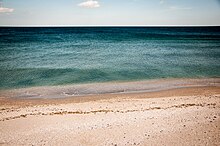Ocean

An ocean is a large area of water between continents. Oceans are very big and they join smaller seas together. Oceans (or marine biomes) cover 72% of Earth.[1] There are five main oceans: the Pacific Ocean, the Atlantic Ocean, the Indian Ocean, the Southern Ocean, and the Arctic Ocean.
The largest ocean is the Pacific Ocean. The smallest ocean is the Arctic Ocean. Many types of animals live in oceans, such as carp, crabs, starfish, sharks, and whales. Different water movements separate the Southern Ocean from the Atlantic, Pacific and Indian Oceans. The Southern Ocean is also called the Antarctic Ocean, because it covers the area around Antarctica.
The deepest ocean is the Pacific Ocean. The deep ocean is characterized by cold temperatures, high pressure, and complete darkness. Some very unusual organisms live in this part of the ocean. They do not require energy from the sun to survive, because they use chemicals from deep inside the Earth.
Color[change | change source]
Although many people believe that the oceans are blue because the water reflects the blue sky, this is actually not true. Water has a very slight blue color that can only be seen when there is a lot of water. However, the main cause of the blue or blue/green color of the oceans is that water absorbs the red part of the incoming light, and reflects the green and blue part of the light. We then see the reflected light as the color of water.

Plants and animals[change | change source]
Many organisms live in oceans. Organisms that live in oceans can live in salt water. They are affected by sunlight, temperature, water pressure, and water movement. Different ocean organisms live near the surface, in shallow waters, and in deep waters. Small plant organisms that live near the surface and use sunlight to produce food are called phytoplankton. Almost all animals in the ocean depend directly or indirectly on these plants. In shallow water, you may find lobsters and crabs. In deeper water, marine animals of many different shapes and sizes swim through the ocean. These include many types of fish, such as tuna, swordfish and marine mammals like dolphins and whales. The skies above the open ocean are home to large sea birds, such as the albatross.[1]
Harvesting the ocean[change | change source]
Nations like Russia and Japan have lots of huge ships that go to some of the world's best fishing areas for many months. These large ships have libraries, hospitals, schools, repair (fixing) shops and other things that are needed for fishermen and their families.
Many people look at the sea as a source of food, minerals and energy.
Fishing[change | change source]
According to the FishBase.org website, there are 33,200 known fish species, many of which live in the oceans.[2] Many of these fish are a fine source of protein, so many people eat them. Fishing industries is very important because they make jobs and give food to millions of people. Today, usually through ocean fishing, the ocean supplies about 2% of the calories needed by people.[3] Tuna, anchovies, and herring are harvested close to the surface of the ocean.[3] Pollock, flounder, and cod are caught near the ocean floor.[3] More than a million tons of herring are caught every year in the North Pacific and North Atlantic, and almost eight fish out of ten fish are eaten as food for humans. The other fish are used as fertilizer, glue, and pet and other animal food.[3]
Ocean temperatures[change | change source]
There are many different ocean temperatures in the open ocean, both vertically (from top to bottom) and horizontally. Icebergs are made over very cold waters at either pole, while waters at the equator are pretty warm.[3] Water cools and warms more slowly than land does, so land influenced by the ocean has later and milder seasons than land that is farther away from the ocean.
The surface part of the ocean, also called the mixed layer, is not much colder even when we go deeper down.[3] Below this surface zone is a layer of sudden temperature difference, called a thermocline. This is a middle layer hat is from the surface zone down to about 2,600 feet (800 m). Thermoclines may happen only at seasons or permanently, and may change depending on where and how deep it is. As evaporation happens, it begins cooling, and if the water evaporates very quickly, the water becomes saltier. The salty, cold water is denser, so it sinks. This is why warm and cold waters do not easily mix. Most animals and plants live in the warm upper layer. Below the thermocline, the temperature in the deep zone is so cold it is just above freezing - between 32–37.4 °F (0–3 °C).[3]
Related pages[change | change source]
References[change | change source]
- ↑ 1.0 1.1 Dinorah Pous (2010). Blue Planet. New York: McGrawHill. p. 117.
- ↑ "FishBase". Archived from the original on 2017-08-23. Retrieved 2015-09-14.
- ↑ 3.0 3.1 3.2 3.3 3.4 3.5 3.6 Sherwin, Frank (2004). The Ocean Book. P.O. Box 726, Green Forest, AR 72638: Master Books. ISBN 0-89051-401-1.
{{cite book}}: CS1 maint: location (link)
